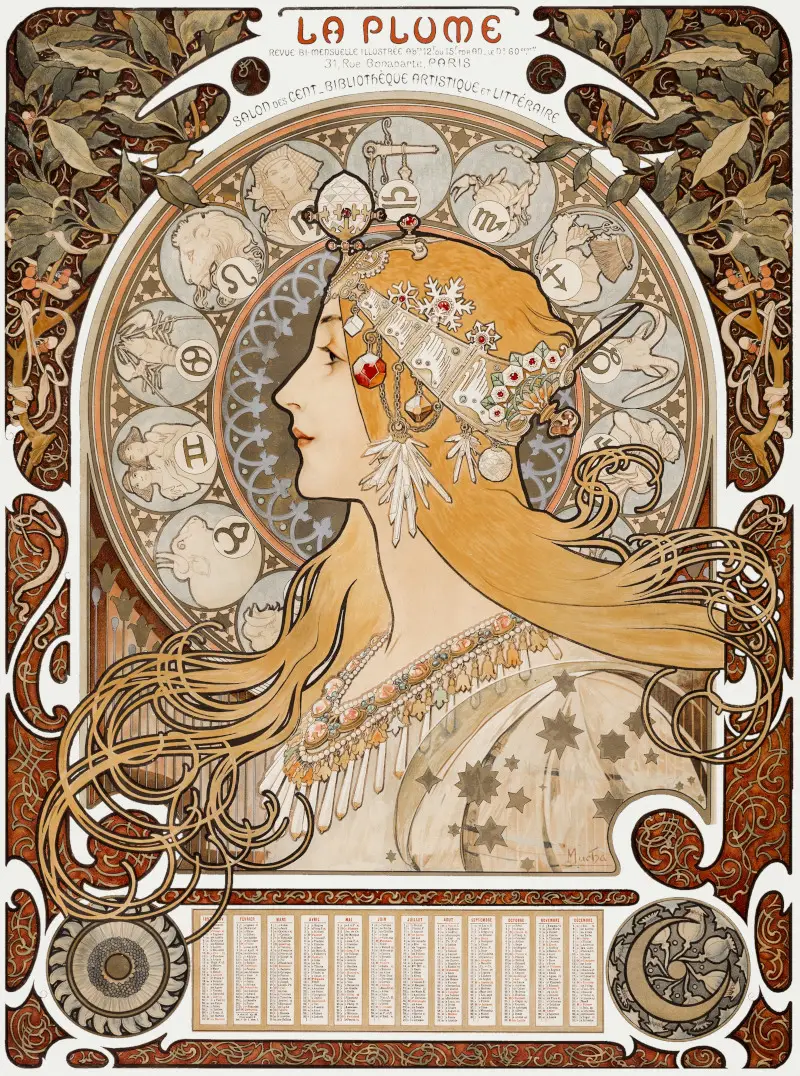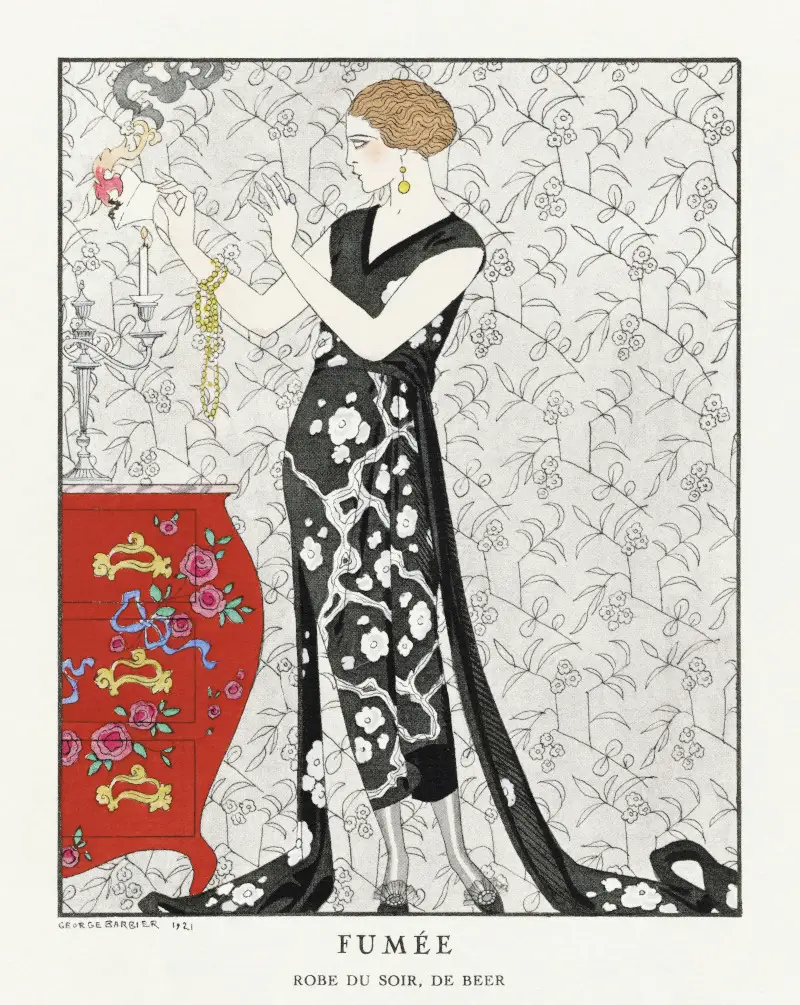Discover the most famous Art Nouveau artists in this extensive article, which includes discussion of the movement itself.
Introduction to the Art Nouveau movement
The Art Nouveau was an art movement which appeared across Europe in the late 19th century and featured long, flowing lines and the promotion of illustration techniques. It covered a wide variety of artistic disciplines, including jewellery, architecture and furniture, but the main focus of this article is in famous Art Nouveau painters.
Many nations had their own offshoots of this movement, and so there was plenty of scope for creativity and variation within this overall umbrella term of the Art Nouveau. Interestingly, modern audiences have truly warmed to the artists listed in this article, and the movement retains as much support today as it ever has.
List of Famous Art Nouveau Artists
We have selected the best artists from Art Nouveau art and included them below, with short biographies and a summary of their careers. There are also images of their most famous paintings. Besides the artist list, we also provide information on specific elements of the movement itself, including its wider impact on the direction of European art.
Art Nouveau art is extremely popular currently, and the artists listed below are regularly requested for exhibitions, as well as reproduction prints. The beauty and technical mastery of their work is well understood and its spread across Europe has helped its legacy to remain strong up to the present day.
Gustav Klimt
Gustav Klimt remains one of the most famous European artists of all time and played a major role in the rise of the Vienna Seccessionists. His highlights included The Kiss and The Tree of Life and many of his larger commissions were produced in a mural format.
This was an artist who mastered figurative art to an extraordinary level, but also was an accomplished landscape painter. He loved to incorporate gold leaf paint into much of his work, and possessed a positive, modern style which persisted throughout his career.
This talented man also works on interior decorations and was not just a visual artist, helping him to complete a variety of commissions for high ranking members of Austrian society as well as some significant institutions. His paintings remain amongst the most reproduced of any European painter, and his popularity is as strong today as it ever has been.
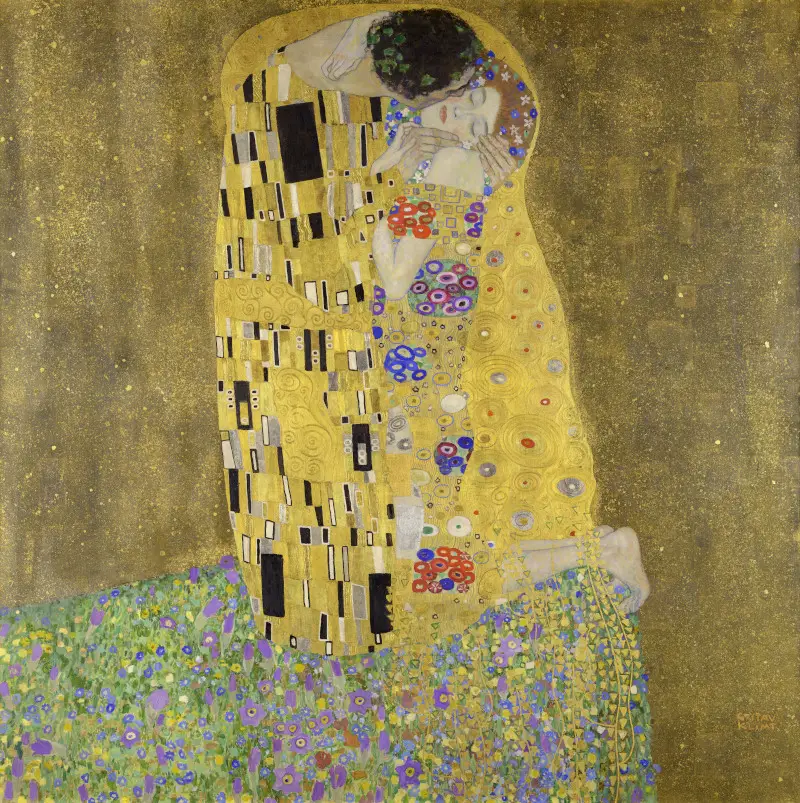 The Kiss - Famous Art Nouveau Painting by Gustav Klimt
The Kiss - Famous Art Nouveau Painting by Gustav Klimt
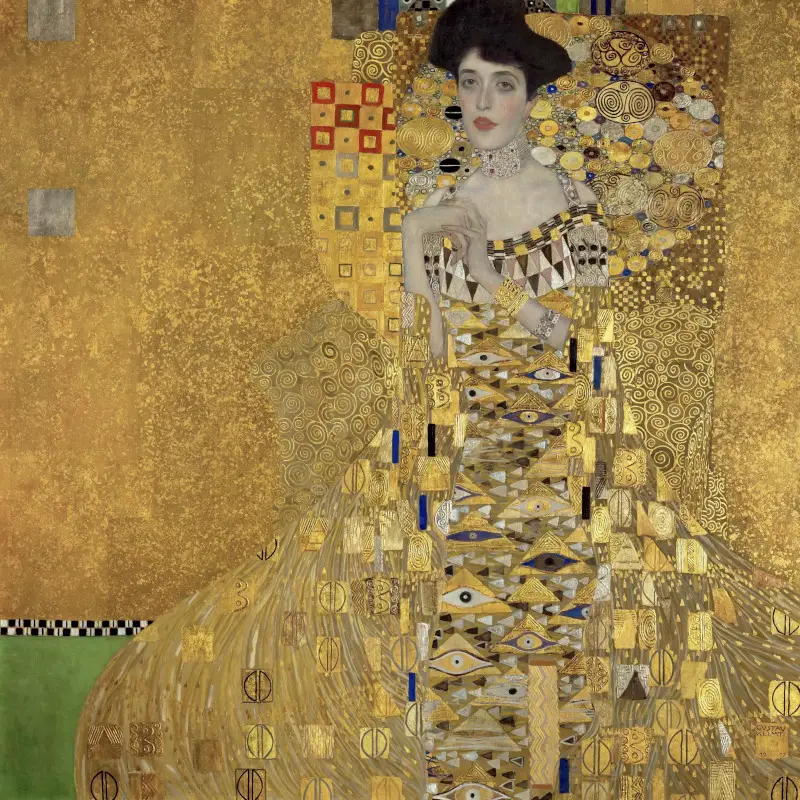 Portrait of Adele Bloch-Bauer I by Gustav Klimt
Portrait of Adele Bloch-Bauer I by Gustav Klimt
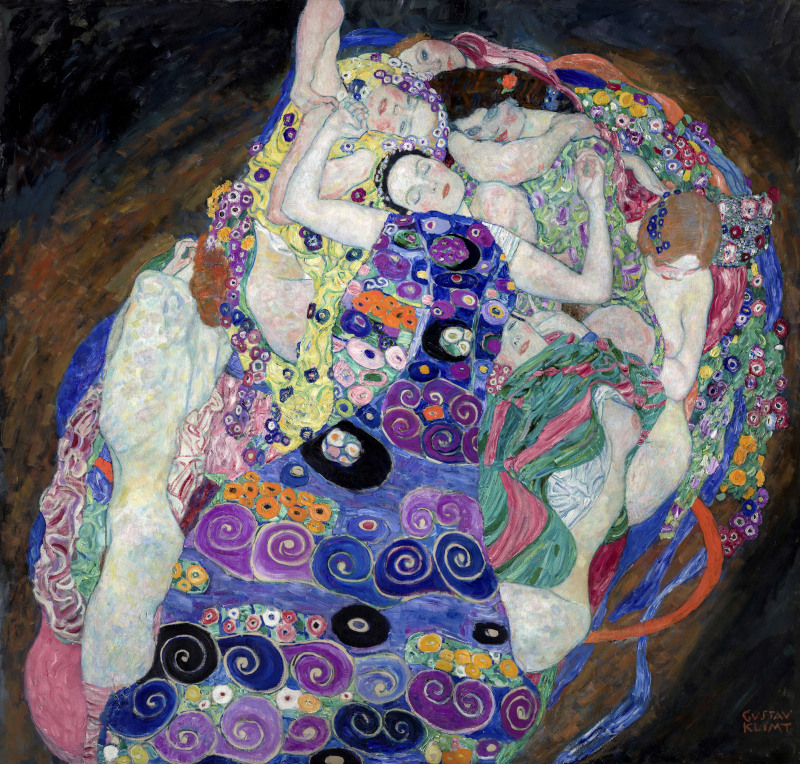 The Virgin Painting by Gustav Klimt
The Virgin Painting by Gustav Klimt
Alphonse Mucha
Alphonse Mucha was a talented illustrator who produced some memorable advertisement posters whilst living in Paris. His gift in capturing the beauty of the female body, whilst also incorporating detailed patterns, made him a major figure within the Art Nouveau movement.
Besides classic works such as Job and Gismonda, the artist also created his Slav Epic series which celebrated the history of his people. Mucha today is seen as an inspirational illustrator whose work has stood the test of time. He was also important in the evolution of advertising, taking on a breadth of commercial entities through his poster designs.
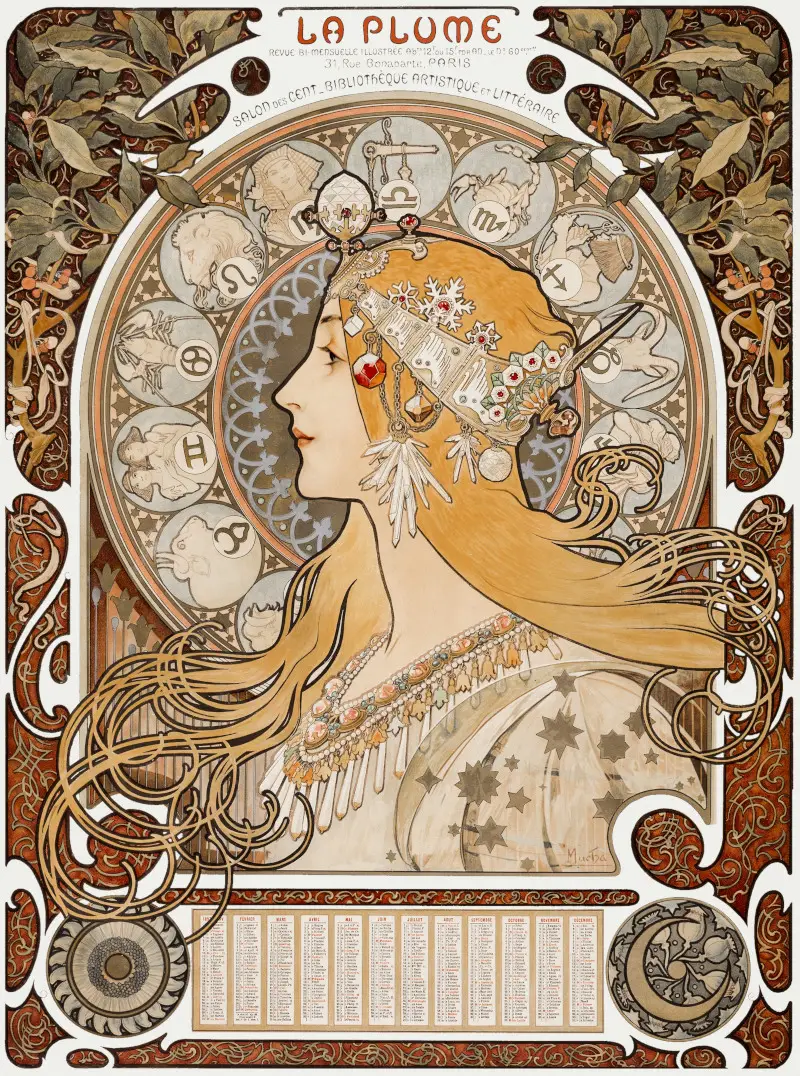 La Plume, Famous Art Nouveau Painting by Alphonse Mucha
La Plume, Famous Art Nouveau Painting by Alphonse Mucha
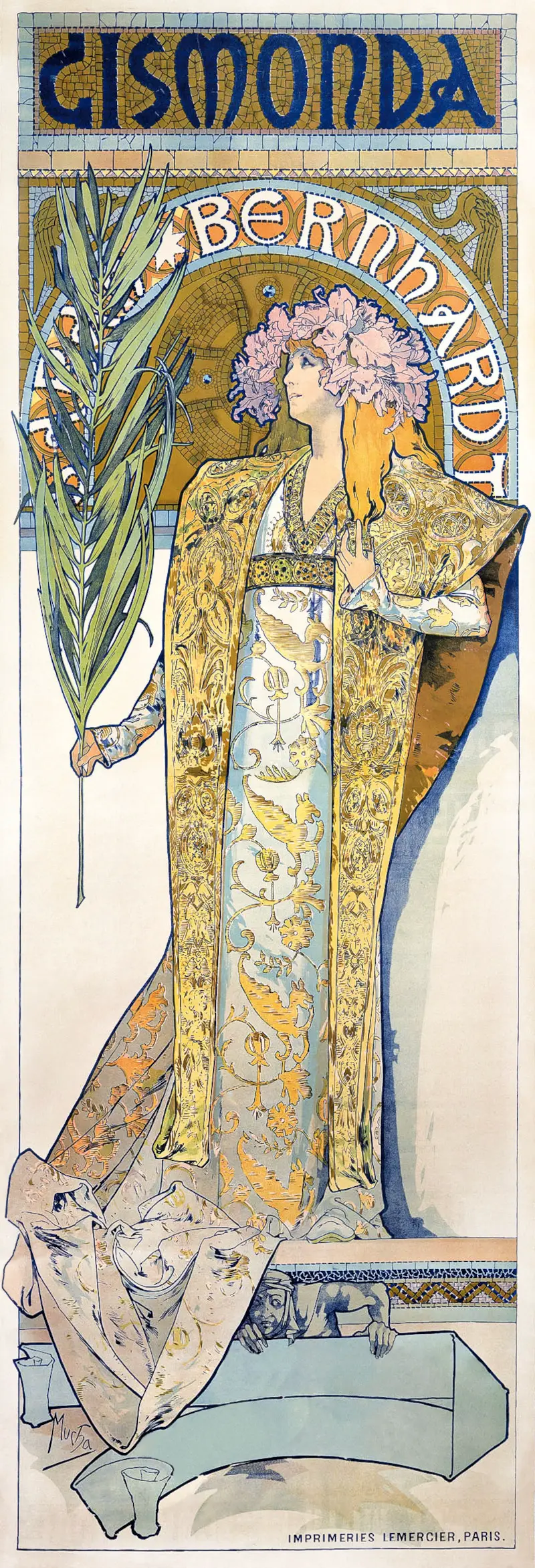 Gismonda Art Nouveau Illustration by Alphonse Mucha
Gismonda Art Nouveau Illustration by Alphonse Mucha
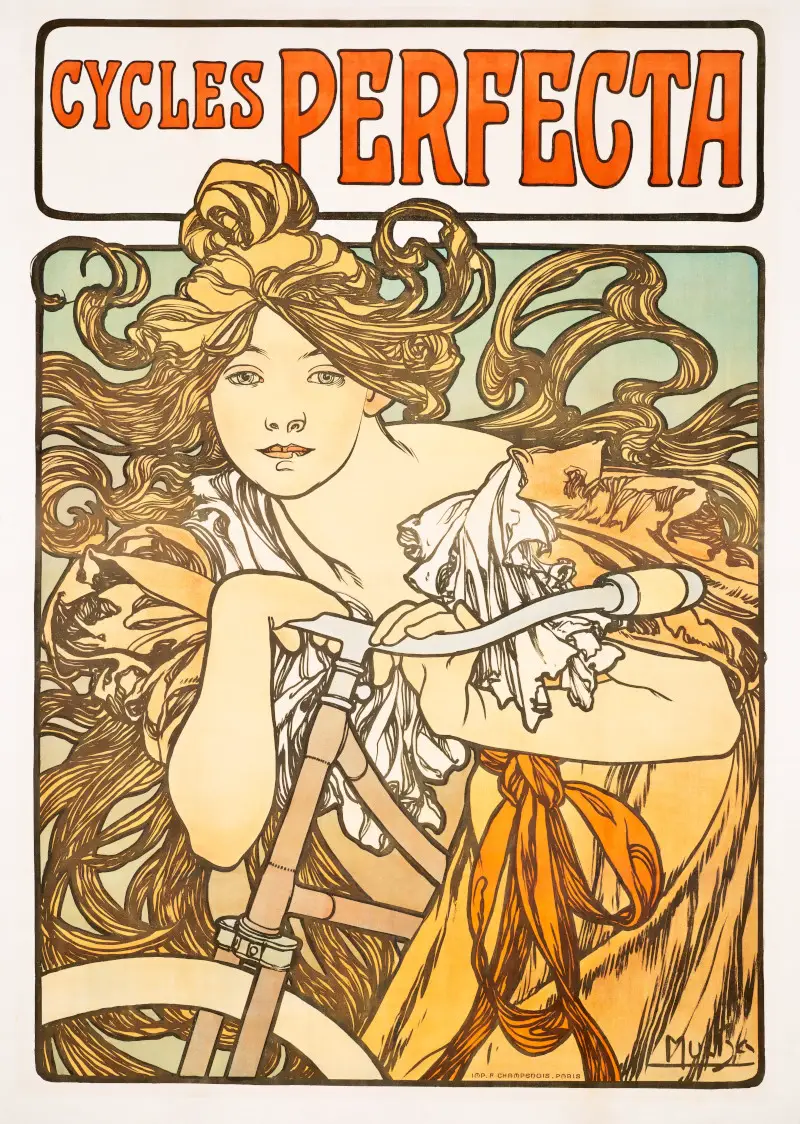 Cycles Perfecta Art Nouveau Advertisement Poster
Cycles Perfecta Art Nouveau Advertisement Poster
Henri de Toulouse-Lautrec
Henri de Toulouse-Lautrec was a lover of Parisian Cabaret and was tasked with producing advertisements to promote various shows in the city. His delightful posters captured the beauty and energy of this art form, and would be placed all across Paris, helping to attract new customers.
This line of work allowed Toulouse-Lautrec to immerse himself in the unique community of French theatre, which he found welcoming even to someone suffering considerable disabilities. Many of these designs would become Art Nouveau masterpieces, including Moulin Rouge and Ambassadeurs, Aristide Bruant.
 Moulin Rouge Toulouse-Lautrec Theatre Cabaret Poster
Moulin Rouge Toulouse-Lautrec Theatre Cabaret Poster
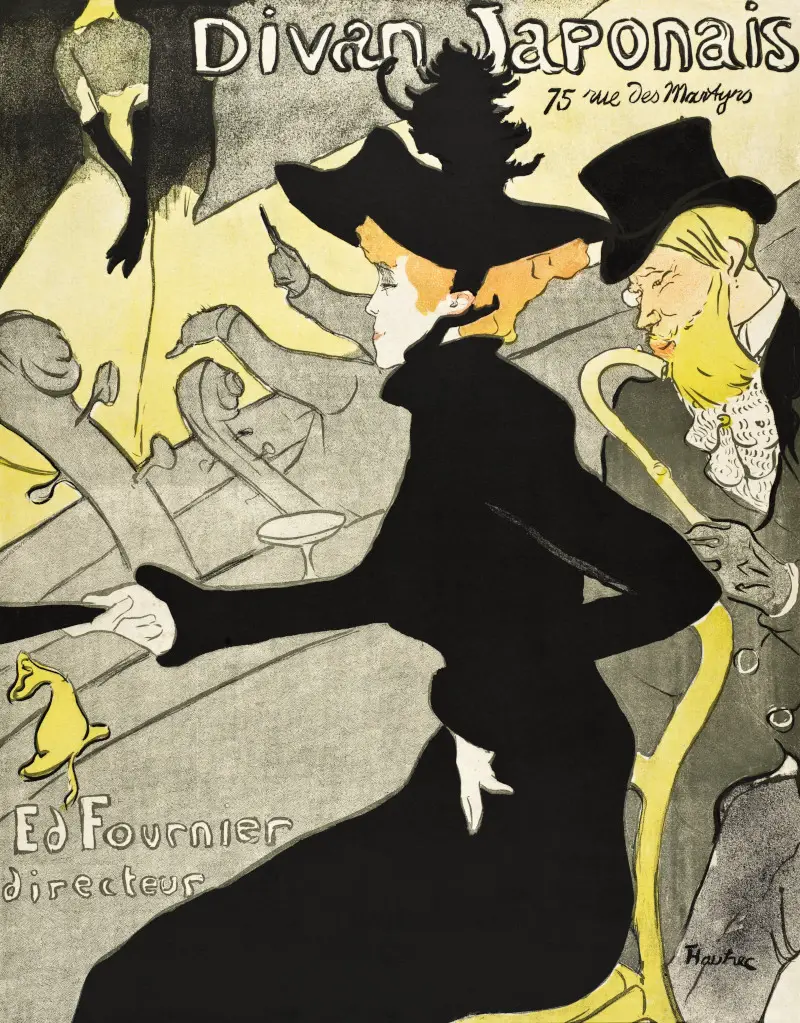 Divan Japonais by Henri de Toulouse-Lautrec
Divan Japonais by Henri de Toulouse-Lautrec
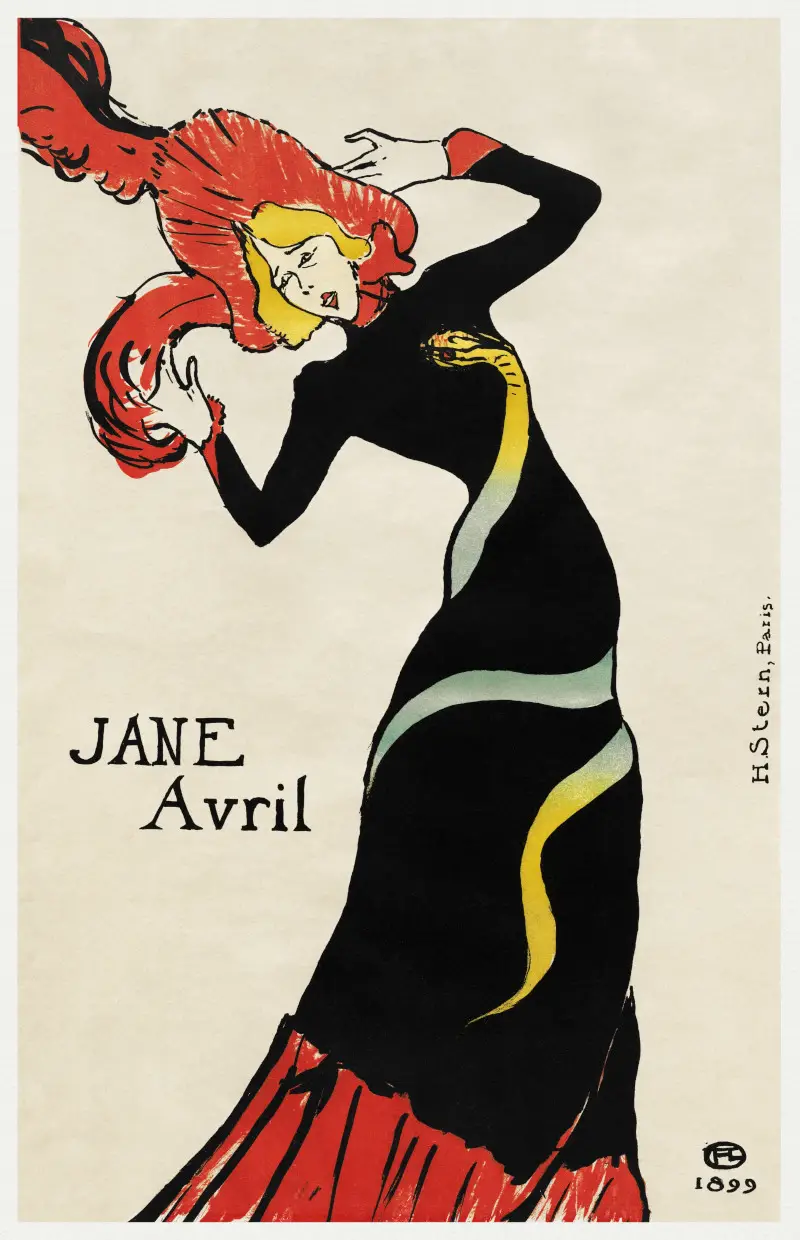 Jane Avril by Henri de Toulouse-Lautrec Art Nouveau Famous Painting
Jane Avril by Henri de Toulouse-Lautrec Art Nouveau Famous Painting
Aubrey Beardsley
Aubrey Beardsley was a talented illustrator whose drawings tended to be reduced down to black and white for maximum impact. Some of his figurative designs were considered controversial for the ways in which they depicted the female body, but in more recent times the quality of his work has been better understood.
Beardsley was a British illustrator who found influences in French art. He worked on a number of publications, providing illustrations for magazines which helped him in the early days of his career. The Peacock Skirt is perhaps his most famous drawing.
 The Yellow Book Cover Design by Aubrey Beardsley
The Yellow Book Cover Design by Aubrey Beardsley
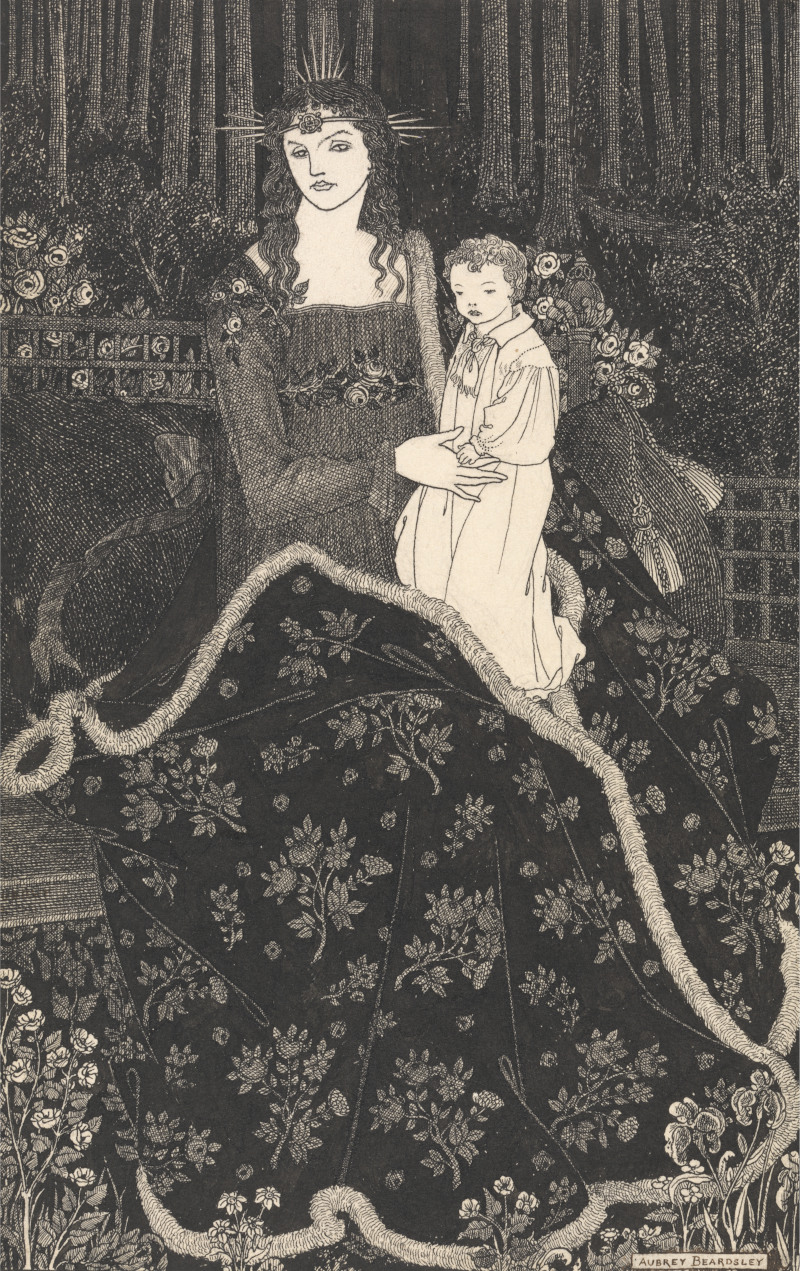 A Large Christmas Card Illustration by Aubrey Beardsley
A Large Christmas Card Illustration by Aubrey Beardsley
Antoni Gaudí
Antoni Gaudí is one of the most famous 19th century architects and was a key part of the Catalan Modernism movement. He remains most famous for his work on Sagrada Familia, though many other examples of his work remain today, and can be visited by the public. Gaudí was a true artist who loved to get involved in many different artistic disciplines.
Whilst planning the external architecture, he would also start to design the interiors too, including furniture and elaborate hanging art. His style suited jewellery design, and there seemed no end to the creative potential of this artistic genius. He remains one of the most highly regarded Spanish artists, of any discipline.
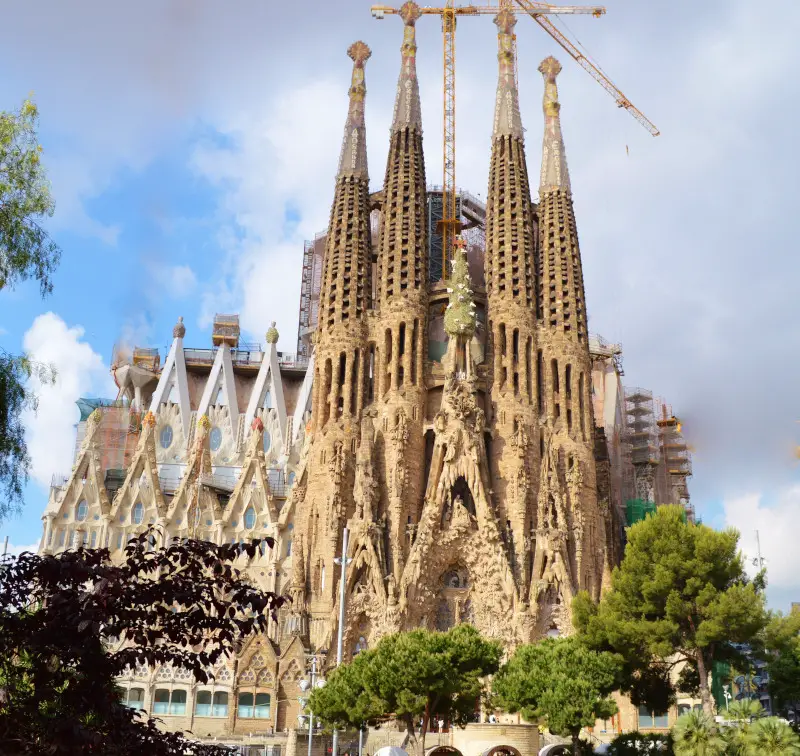 Sagrada Familia Spanish Art Nouveau by Gaudi, image courtesy of Rawpixel
Sagrada Familia Spanish Art Nouveau by Gaudi, image courtesy of Rawpixel
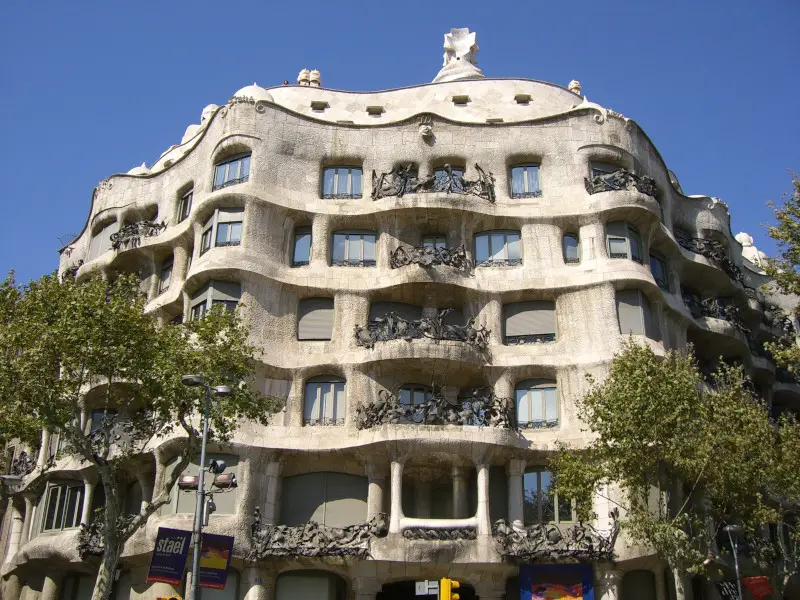 Gaudi Architectural Design, image courtesy of Rawpixel
Gaudi Architectural Design, image courtesy of Rawpixel
George Barbier
George Barbier was a significant French illustrator from the turn of the century who specialised in Art Nouveau figurative art. His intricate, classy designs perfectly captured the mood of the period, and also represented the unique fashion displayed in the era of the Art Nouveau.
Whilst being overshadowed by the likes of Mucha and Beardsley, Barbier's work has received greater attention in recent years as lovers of the Art Nouveau start to delve a little deeper into its extensive list of famous artists. Barbier's work is also highly accessible and impactful, requiring little explanation or backstory to his art.
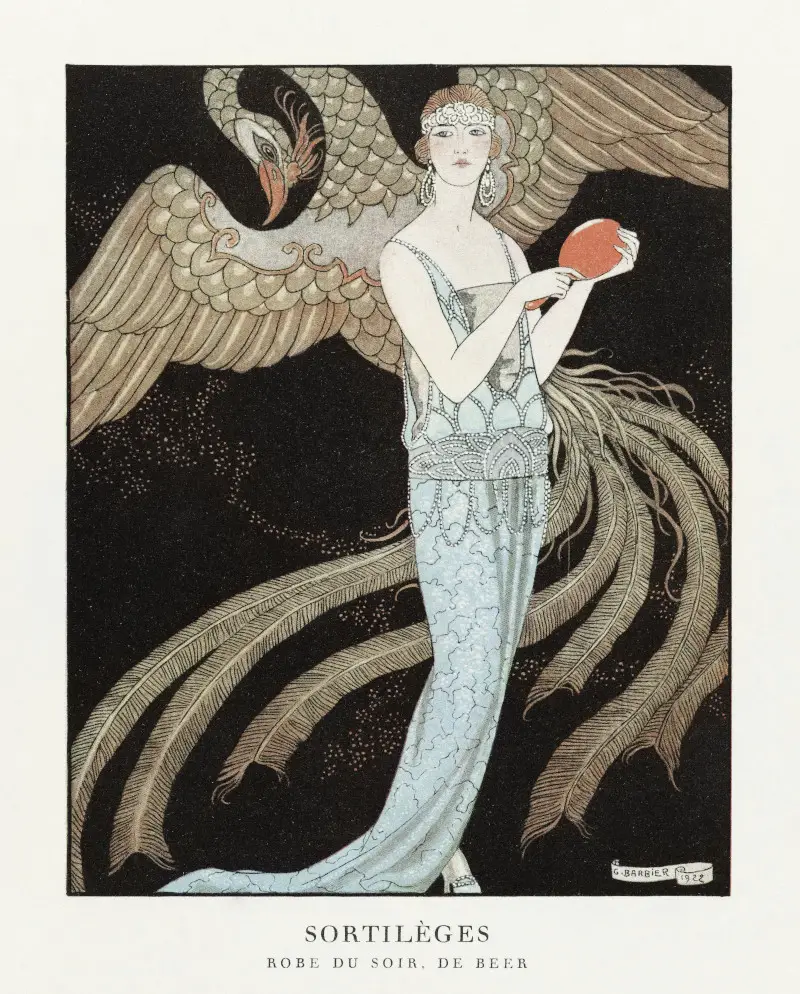 Evening Dress - Art Nouveau Fashion by George Barbier
Evening Dress - Art Nouveau Fashion by George Barbier
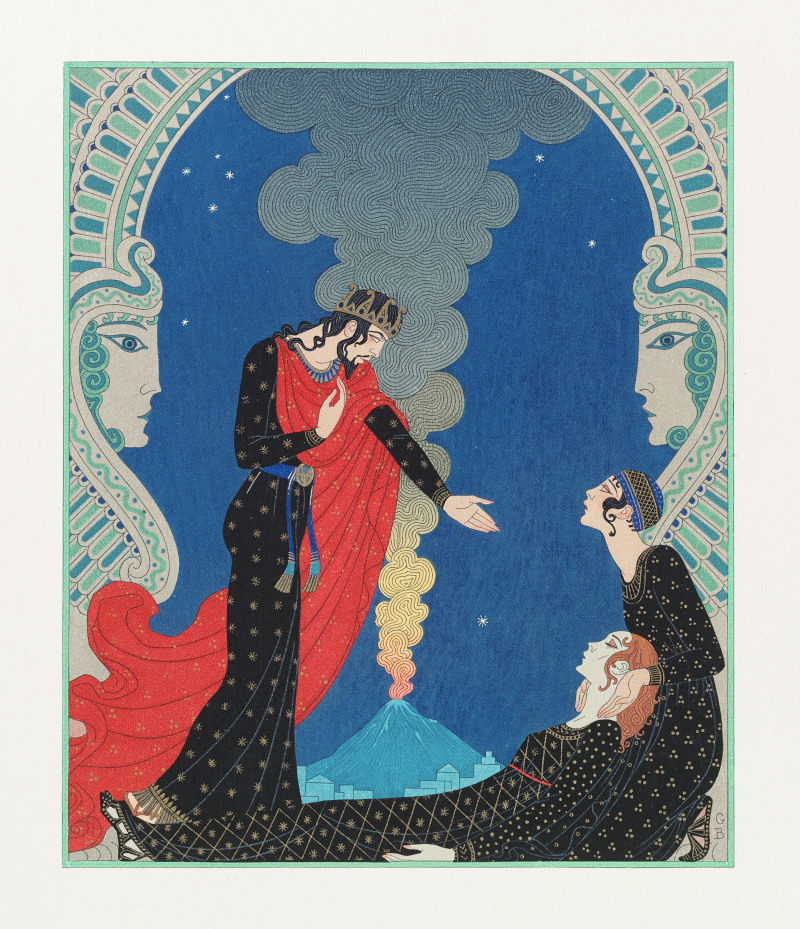 Empedocles and Panthea Illustration
Empedocles and Panthea Illustration
Charles Rennie Mackintosh
Charles Rennie Mackintosh was a respected and talnted Scottish designer from the 19th and 20th century. He spread his talents across many disciplines, always striving for new challenges. He remains best known as an architect, but also worked as a furniture designer and painter, amongst other things.
A number of his architectural designs remain standing today, and in a similar manner to Gaudi, some contain other aspects of his oeuvre inside. He is considered one of the most famous Scottish artists in history, and was a leading figure in the Art Nouveau movement.
The Birth of Art Nouveau
In truth, the Art Nouveau label is a collective term which relates to a number of contemporary art movements that appeared across Europe over a period of several decades. It may well have been a reaction to the growing industrialization of Europe, with artists seeking to return to nature.
There was also a desire to avoid the mass production of modern life, encouraging artists to revive and protect traditional techniques and keep the handmade methods alive for future generations. This appeared to be the only way to avoid homogenous products replacing creativity in the future, in a similar battle to how some view the threat of ai today.
In order to preserve the handmade methods, artists of the Art Nouveau would stretch its values across a wide range of disciplines. Most famously, this would impact furniture, jewellery, architecture and graphic design. Many of their designs were so charming that they continue to inspire younger generations of artists, a good century later.
The birth of Art Nouveau art also attempted to encourage social change, with most of its members holding left-of-centre political views. Many aspects of the movement still feel very relevant today, and the likes of Mucha and Klimt remain highly regarded within the European art mainstream.
Historical Context: The Fin de Siècle Spirit
The Art Nouveau is often said to have come about during the Fin de Siècle, which translates from French as the end of the century. This term relates to more than just a formal period of time, but rather represents changes in soceity, and a desire to push towards the modern world.
The Fin de Siècle spirit is said to represent bot the good and bad of modern life. There were advancements in technology, including automobile and telephone advancements which changed everyone's lives. There was also an improved efficiency in production, through the use of better machinery.
In contrast, though, artists wanted to return to a more simple life, with handmade techniques and an appreciation of nature and its inherent beauty. This battle continues today, with the rise of AI and social media, bringing a greater reliance on technological connections, and an abandonment of healither behaviour.
Regional Movements of the Art Nouveau
One can point to the spread of the Art Nouveau by examining the various sub-groups. These included Jugendstil in Germany, Modernismo in Spain, Stile Liberty in Italy, and in Austria there was the Vienna Secessionists. The term of Art Nouveau came directly from France, and despite these groups working independently, they ended up following a similar base of artistic principles.
Besides those nations, there were also contibutions from the Czech Republic, Belgium, UK and many more besides. The US also was welcoming to these ideas and started to promote some of its own innovations which ran closely alongside their European counterparts.
The Origins of Art Nouveau: Influences and Precursors
Much of the 19th century was dominated by the battle between modern and traditional life. Mass production worked against the wishes of artists across Europe and a number of artistic developments occurred because of this. This atmosphere of a desire to return to nature seemed to be felt all across the continent, as similar art movements started to appear independently of each other, and eventually they would be grouped together under the term of Art Nouveau.
French art was highly influential during the 19th century and it was perhaps from here that some of these ideas first appeared. Paris had long since attracted artists from other nations, seeing it as the artistic capital which offered the most opportunities, and so anything happening here was always likely to spread elsewhere in time.
Nature as Inspiration: The Celebration of Organic Forms
Motifs of nature regularly appeared in Art Nouveau designs. The infinite variation in the natural world ensured unique art, though there were some ideas that persisted consistently across a number of careers. Plants, flowers and vines were incorporated into illustrations to add interest across each scene, often intertwining with the main focal points in an organic manner.
Mucha, for example, would capture portraits of young women but surround them with elements of nature to create a harmonious balance to his work. The addition of carefully selected, classical fonts would complete the look. Alongside flowers and plants, there would also be beautiful creatures, such as butterflies, birds, dragonflies and peacocks, basically anything that was aesthetically pleasing and that would fit alongside the plants, flowers and vines.
Furniture design also made use of these elements, often as decorative borders which ran alongside the side of each design. Sculptors and craftsmen would specialise in carving particular flowers, or printing their designs into wallpaper or textiles.
The Whiplash Curve: A Distinctive Art Nouveau Motif
There was a motif which appeared regularly within Art Nouveau design which became known as the Whiplash Curve. It was a natural and flexible formation of line that could be applied to visual arts, furniture and architecture. Its simplicity made it highly adaptable and it fitted perfectly with the inclusion of nature, birds and animals, that was also a persistent method in this movement.
Many artists would use it in a dominating fashion, striking across the centrepiece, before applying related details either side in an organic manner. Outlines of attractive creatures could then be used as supporting motifs, and repeated several times over.
Japonism and Oriental Influences in Art Nouveau
Japonism brought about a fusion of cultures and aesthetic sensibilities, becoming an important category of the Art Nouveau. Japanese art would inspire many western artists, some years before the Art Nouveau, but Japonism was a specific art movement which is worthy of note. Previously, the likes of Van Gogh and a number of Impressionists would collect imported Japanese prints, making copies of them and learning from their unique qualities.
These changes were caused by Japan re-opening to the world after years of seclusion. Little was known about the country in the west, and what was discovered excited artists. New ideas in color, paintings techniques and composition were presented to them as major trading routes brought Japanese art into Europe.
The reliance on nature by Japanese artists sat perfectly with the ideals of the Art Nouveau, and so they started to merge some of these ideas into their own. Cherry blossoms, bamboo, cranes, and waves could be used alongside the plants and flowers native to the west. Indeed, this encouraged artists to look even further afield, discovering the qualities of Persian art, some related Chinese artists and Islamic art as well. Whistler's decorative work in the Peacock Rooms is another fine example of how western and Japanese art could be combined effectively.
The Role of Women: Depictions of Femininity in Art Nouveau
Whilst there were not many successful female artists within the Art Nouveau movement, women would still play an important role within its success. The female figure and portraiture more generally would form a large part of the content in this style, and suited the use of nature as inspiration. Much of this style was based on a subtle beauty, with male characteristics such as strength and bravery being unsuitable.
Women artists had achieved success in other movements, either side of the Art Nouveau, and it is perhaps surprising that an art movement so focused on femininity would be dominated by male artists. The best models would become household names, and some of them were not professional models, but rather actresses from theatre who would appear in advertising for their shows.
The Kiss by Gustav Klimt would perhaps provide the best example of women in the Art Nouveau, as well as some of the poster art by Mucha and Toulouse-Lautrec. Either way, it was a celebration of femininity and the beauty of the female body.
Architecture and Art Nouveau: Transforming the Urban Landscape
Art Nouveau architecture attempted to see a building as a work of art, and to combine artistic elements with its main structure. This would herald original designs and considerable amounts of work in finetuned detail, though also helping to attract a new audience to architecture who saw it as an extension of art .
Contributions were to be made in Brussels, Paris, Barcelona, Glasgow, and Vienna, from the likes of Victor Horta, Antoni Gaudí, Hector Guimard, Charles Rennie Mackintosh, and Otto Wagner, and many of their creations continue to be lauded today. There was no a smaller gap between a building and its contents.
Interior Design and Art Nouveau: Creating Aesthetic Spaces
Art Nouveau interior designers would call on inspiration from nature for much of their work. Colors would be selected to match trees, plants and flowers, and patterns would repeat motifs of flower heads and intertwining vines. All of these graphical symbols would repeated across the room, in wallpaper, furniture, textiles and also in stained glass windows.
Some would be tasked with overseeing the entire building and its content, in order to ensure a consistent approach throughout. Even the architecture could potentially be given stylistic details that matched the interior design, treating the overall structure as an artistic project, requiring a holistic approach.
Art Nouveau Jewelry: Beauty and Elegance in Adornment
Art Nouveau jewelry contained the essence of the movement, including a devotion to nature, and the use of swirling patterns, combined with the elegance and beauty of the female figure. Curves were encouraged in design, mimicing waves and swirling flowers. There was also a return to high levels of craftmanship, along with the combination of art within jewelry. Geometric patterns were rejected in favour of natural and organic lines.
Over time a series of symbolic motifs would develop and these could be used in all disciplines, creating a consistency between one's clothing, jewelery, as well as between a building and its contents.
Graphic Design and Art Nouveau: From Posters to Typography
Many of the styles of Art Nouveau illustrators would make their way into the graphic design industry. Even today, designers will seek out elements from their work to include within their own, such as flourishes of line, or outlines of butterflies, flowers and many other items. Typography became a major part of the movement too, and this would impact contemporary graphic design, with some of their fonts still being used today.
Poster design became another artistic expression thanks to the exciting contributions from this period. Creativity was to be encouraged in order to produce something memorable that could better sell a product or service. The success of these famous illustrators helped to bring opportunities to others in a commercial role, with poster advertising becoming a major part of the marketing output until the rise of television and internet advertising.
Art Nouveau and the Applied Arts: Furniture, Ceramics, and Glassware
Floral patterns and flowing lines had been used in ceramic designs for centuries, but were now entirely appropriate within the Art Nouveau era, carefully designed to match their accompanying furniture and other elements of interior design. Glassware could do the same likewise, and flowing lines could be translated into incredible craftsmanship within glassware.
The level of detail was extraordinary, with designers even focusing on door knobs, fireplaces, light fittings, and anything else that could be used to promote and continue their overall design brand. This encouraged designers to learn more about different art forms, and not simply sit comfortably in one product type. Commissions would often require them to design across disciplines, with an overall mood in mind.
Art Nouveau and Fashion: Influence on Clothing and Accessories
Much of the influence made by Art Nouveau in other movements would also continue into fashion. It was almost a brand, in which the same motifs, inspired by nature, could spread flexibly from architecture, into the visual arts, on to furniture and then into fashion and accessories. Floral patterns and a feminine style worked perfectly in this female-dominated industry.
The connection to nature would bring in green and brown tones, best suiting autumn and winter looks. Design was also about opulence, connecting to stunning jewelry, and clothing would be designed in a way which matched the same approach. Hats were popular in asserting this atmosphere of elegance, giving hat makers extra opportunities at around the turn of the century.
The Legacy of Art Nouveau: Influences on Later Art Movements
There were many art movements which appeared towards the end, or just after, the era of the Art Nouveau. Art Deco was the most similar of these and used many of the same motifs. Modernism and Bauhaus also can clearly be linked to it, and helped to continue the evolution of European art towards the contemporary art forms that we enjoy today.
Art Nouveau in Different Countries: Regional Variations and Adaptations
The Art Nouveau spread to different nations, and received new terms in each territory. Whilst the French created this umbrella term, the same approach elsewhere became known as Jugendstil in Germany and Modernismo in Spain. Additionally, there was the Stile Liberty in Italy, and in Austria there was the Vienna Secessionists which included Alphonse Mucha. Over time, the spread would go further, taking individual contributions from other nations such as Belgium, the UK, and the US.
Whilst these terms are related, there was a little variation between the output, depending on the disciplines in which these regions were already familiar. Furniture design in the UK was already well established, and so that became a major part of the British Art Nouveau scene.
Conclusion: The Enduring Beauty and Significance of Art Nouveau
We can conclude that the Art Nouveau era brought about a return to nature for many artists, and a rise in prominence for illustration. Whilst many will be aware of the major names such as Mucha, Klimt and Toulouse-Lautrec, the overall output should be considered by its overall effect on the direction of European art, rather than being reduced to the accomplishments of just a few artists.
The Art Nouveau also helped to remind us all of the importance of handmade designs, and traditional techniques, and that the modern world have some downsides that needed to be guarded against. These lessons are entirely relevant today, with the rise of AI, and the potential impact that it might have on individual expression and the integrity of art itself.
In terms of illustration, there was also a cross-over between commercial employment, producing advertising, and visual artistry, where a design might actually be celebrated as an artwork, even masterpiece, in its own right. What were intended as simple adverts, Mucha and Toulouse-Lautrec created artworks that continue to be celebrated today.



